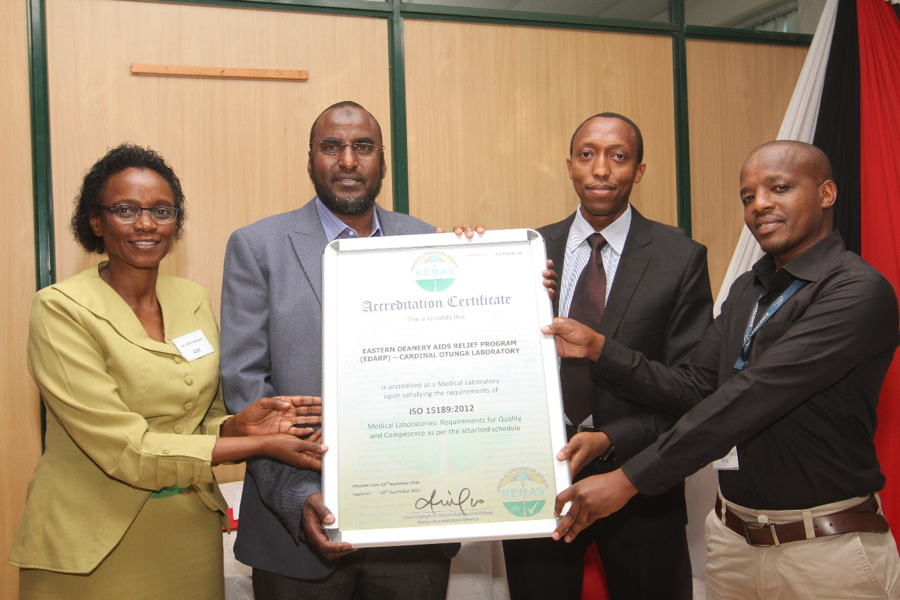EDARP Cardinal Otunga Laboratory 2, Kenya

From left: Dr. Jane Mwangi (Laboratory Branch Chief, CDC-Kenya), Mr. Bashir Farah (KAVI Laboratory Manager/Mentor), Mr. David Njoroge (EDARP Laboratory Director), Mr. Kola Mbangula (EDARP Laboratory Manager)
1.What was the hardest thing to do in order to get accredited?
- Setting up a quality management system (QMS) which complies to ISO 15189 - Documenting all system and technical procedures for the laboratory which meet requirements of ISO15189 standard. The following documents posed the most challenge: Quality manual (4.2.2.2); Management review (4.15); Validation of examination procedures (5.5.1.3); Measurement of uncertainty (5.5.1.4).
- Implementing all QMS documented procedures developed. Corrective Action/Preventive Action.
2.What was the easiest?
Meeting the following requirements of the standard - The following were easiest because they required the least financing to close gaps identified: Personnel (5.1-5.1.9); Accommodation and environmental conditions (5.2 -5.2.6); Reagent storage and inventory management (5.3.2.2, 5.3.2.4).
3.What was the most important contributing factor to getting accredited?
- Management support and involvement – Without the involvement of EDARP management it would be very difficult to attain accreditation. Management involvement brought accountability of the process and allocation of resources.
- Trainings – SLMTA trainings provided the laboratory team with;
- Useful tools e.g. monitoring tools for quality indicators.
- Facilitated improvement project reporting,
- Understanding of what the standard required and how it was to be implemented.
- Mentorship – Having a good mentorship team helped a lot in setting up a working QMS system. Mentorship made it easy to decode the standard and understand what was expected to be done.
- Laboratory staff involvement – Accreditation can only be achieved when every person is involved and committed towards its implementation.
4. What steps did you take?
Step 1 : To unlearn our poor practices and learn best practices prescribed by the standard”. This was a trying period because it was a complete overhaul of how laboratory activities were to be conducted. A good example was how quality control was to be implemented, monitored and evaluated.
Step 2 : 100% implementation of documented procedures by the laboratory team. One of the major challenges we faced was having beautiful documented procedures which were not practical. We reviewed our documents consistently to make them simple, practical and ensured they met the standards requirement.
Step 3 : SLMTA trainings helped in bringing the laboratory team up to speed in understanding ISO15189 standard. They were very practical.
5. What were the biggest mistakes you made?
Starting the process without proper sensitization of all laboratory and stakeholders on implementation of ISO15189 standard. All key stakeholders need to be sensitized on implementation of the standard. This is a very critical training that made a big difference once it was undertaken. All stakeholders better understood what the standard expected them to do and it enable the implementation team identify gaps and develop action plans to address them.
6. What is the best advice you can give to others?
Firm leadership and collective team work: Every person is important in the process and they should work as a team. Laboratory leaders should be 100% committed to the process. Success depends on their leadership and when they are ineffective the entire team will also relax. It will be necessary for us to sacrifice our leisure time to ensure all requirements were met. We had to create extra time to get the work done.
7.How much did it cost?
- EQA programs*(Two programs) = $6768.34
- Licenses Ksh. 68500 ($696.14)
- Assessment audit fee Ksh.840,000 ($8536.6)
- Calibration Ksh 200,000 ($2032.52)
- Trainings Ksh. 400,000 ($4065.04)
